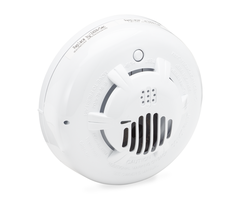How Do Carbon Monoxide Detectors Work?
Carbon monoxide detectors work by detecting unusually high levels of carbon monoxide (CO) in the air. Most carbon monoxide detectors use one of three (3) possible methods for detecting CO gas. If the sensor is activated, it will send an alert to the panel and trigger an instant alarm event.

The presence of too much CO gas is very serious. Carbon monoxide is odorless and tasteless, and exposure kills hundreds of people every year. Many people die in their sleep, as they do not have CO sensors to wake them up and alert them to an outbreak. When a CO detector is activated, it will put the alarm system into an immediate alarm condition. If the user has active monitoring service with a central station, then emergency assistance will be sent to the user's home immediately. A CO alarm dispatch cannot be canceled. Carbon monoxide alarms are taken very seriously, and it is recommended that every home and business has properly working carbon monoxide sensors installed.
A build-up of carbon monoxide gas occurs when fossil fuels are not burned efficiently. Most carbon monoxide deaths occur during the winter months when more heating appliances are used. It is important to avoid using devices like charcoal grills and portable camp stoves indoors. You should also make sure not to run your car or truck with the garage door closed, particularly in an attached garage. Also, have your fuel-burning appliances inspected regularly to make sure they are working correctly. This includes any gas or wood heating system, gas water heaters, and gas-powered generators. It is recommended that you place carbon monoxide detectors near garages and outside of sleeping areas. You should have at least one (1) CO detector on each floor of your home.
Carbon monoxide detectors typically fall into one of three (3) categories. These are biomimetic sensors, metal oxide semiconductor sensors, and electrochemical sensors. All types of carbon monoxide sensors work extremely reliably to ensure that CO outbreaks are detected as soon as possible in every situation. This is crucial for allowing these sensors to operate as true life-safety devices. The alarm industry has embraced the electrochemical sensor. Sensors using this technology work well, and are affordable enough to be properly deployed. Most of the CO detectors that we sell are of this variety. However, if you have a biomimetic sensor or a metal oxide semiconductor sensor, then it should still work just fine. It is just important to make sure that the device is compatible with your system and that the sensor has not reached its end of product life.
Electrochemical CO sensors have internal electrodes that are covered in a special chemical solution. This allows changes in electrical currents to occur when the electrodes come into contact with carbon monoxide in the alert amount, usually measured in parts-per-million (PPM). The sensor detects this electrical change, and it activates the alarm. Metal oxide semiconductor CO sensors have an internal silica chip. When this silica chip becomes exposed to carbon monoxide, it causes a drop in electrical resistance. The sensor responds to this drop in electrical resistance by triggering an alarm. A biomimetic CO sensor has an internal gel that changes color when it absorbs carbon monoxide gas. An internal sensor observes the change in color and causes the sensor to activate.
All carbon monoxide sensors can be grouped into two main categories. There are wireless carbon monoxide sensors and hardwired carbon monoxide sensors. If you use wireless CO sensors, you must make sure that they communicate at a wireless frequency that is compatible with your system's wireless receiver. Hardwired CO sensors should only be used with hardwired systems. If a hardwired CO detector has an option to wire either Normally Closed or Normally Open, choose the Normally Open wiring option. Be sure to wire the resistor, if required, in parallel. You should not use a hardwired CO sensor with a wired to wireless converter. Also be aware that most CO sensors have a limited product life, after which they must be replaced. A typical end of product life timeframe for a CO detector is anywhere from four (4) to ten (10) years after the manufacture date.
Did you find this answer useful?
We offer alarm monitoring as low as $10 / month
Click Here to Learn MoreRelated Videos
Related Categories
- Carbon Monoxide Detectors
- Wireless Carbon Monoxide Detectors
- Wireless Carbon Monoxide Detectors
- Carbon Monoxide Detectors
- Wired Carbon Monoxide Detectors
- Wired Carbon Monoxide Detectors
- Answered

